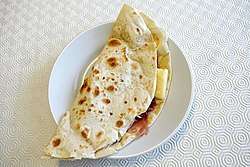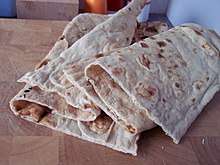Piadina
Piadina [pjaˈdiːna] or Piada [ˈpjaːda] is a thin Italian flatbread, typically prepared in the Romagna historical region (Forlì, Cesena, Ravenna and Rimini). It is usually made with white flour, lard or olive oil, salt and water. The dough was traditionally cooked on a terracotta dish (called teggia in the Romagnol), although nowadays flat pans or electric griddles are commonly used.
 | |
| Alternative names | Piada |
|---|---|
| Type | Flatbread |
| Place of origin | Italy |
| Region or state | Romagna |
| Main ingredients | Flour, lard or olive oil, salt, water |
The Piadina has been added to the list of the traditional regional food products of Italy of the Emilia-Romagna Region.
Origin
The Piadina is typical of the Apennines area of Forlì, Cesena and Rimini, and also of the Ravenna area and the rest of the Romagna region. It is also widespread in the areas of Montefeltro, Pesaro e Urbino province, Ferrara province and the Republic of San Marino.
Etymology
The etymology of the word "piadina" is uncertain; many think the term "piada" (piê, pièda, pìda) was borrowed from the Greek word for focaccia. Others think the term was borrowed from other languages because of the large use of similar foods throughout the Eastern Roman Empire. The term "Piada" was officialized by Pascoli, who adapted the Romagnol word "piè" into its more Italian form.[1] Romagna was heavily influenced by Byzantium during the early Middle Ages when the Eastern Empire reconquered parts of the Western domain which had fallen to the invading barbarians. In those days Ravenna was the capital city of the Exarchate, and that would explain how the Greco-Byzantine recipe entered the local gastronomy.
The first written evidence of Piadina as it is now recognized dates back to 1371, in the Descriptio Romandiolae compiled by Cardinal Anglico, who for the first time gave the recipe of the bread of the people of Romagna; "It is made with wheat flour moistened with water and flavoured with salt. It is then kneaded with milk as well, and also a little lard."[1]
Modern era
Piadine are usually sold immediately after preparation in specialized kiosks (called piadinerie) filled with a variety of cheeses, cold cuts and vegetables, but also with sweet fillings such as jam or Nutella. There may be small differences depending on the zone of production. Piadine produced around Ravenna and Forlì are generally thicker, while those produced around Rimini and the Marche region are thinner and the diameter is greater.
A Belgian company, owned by Swiss group Renzi AG, claims to own intellectual rights over a product called piadina. This can be easily circumvented, simply because piadina is the diminutive of piada and the ratio of ingredients, preparation and presentation can be changed at will.
Piadina has even found its way to space, eaten by Russian astronaut as part of a mediterranean diet experiment on the International Space Station.[2]
| La j'è bona in tot i mud, la j'è bona énca scundida sa' n'avì ancora capì, a scor propri dla pida. |
Delicious with filling or even served plain, if you haven't already guessed, I am talking about the "piadina". |
According to Giovanni Pascoli,
Nothing speaks more of Romagna than this bread of ours... it is a symbol that speaks of devotion to our land.
— [1]
See also
- Crescentina
- List of Italian dishes
References
- Romagna Piadina: from tradition to flavour. Archived July 22, 2011, at the Wayback Machine
- Buon appetito: Russian cosmonauts on a Mediterranean diet. April 27, 2004. Retrieved 28 October 2017
External links
- (in Italian) PiadinaOnLine
- (in Italian) Tracce di storia della piada
